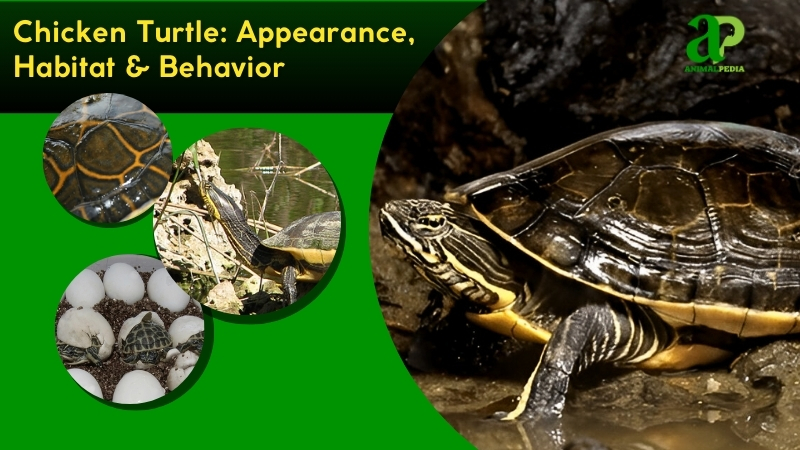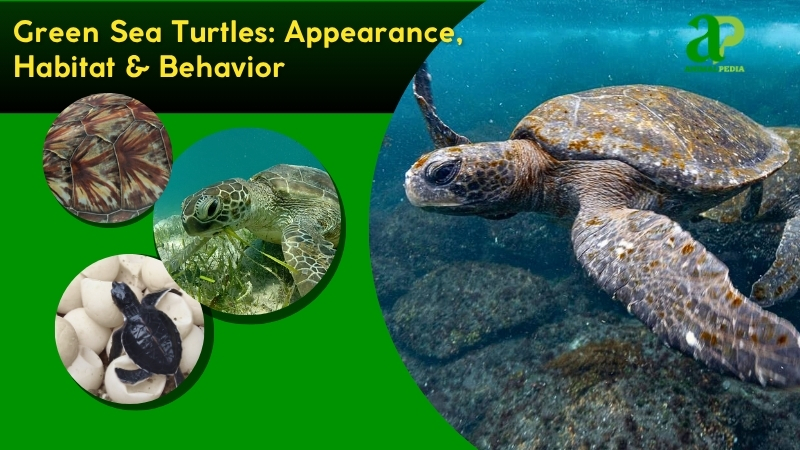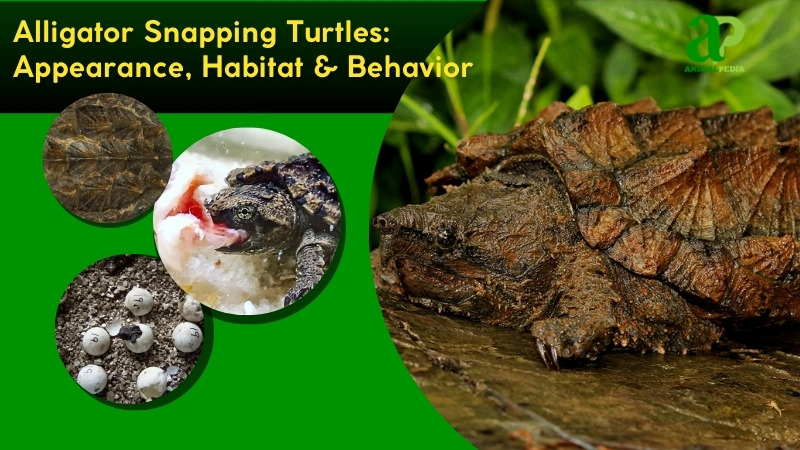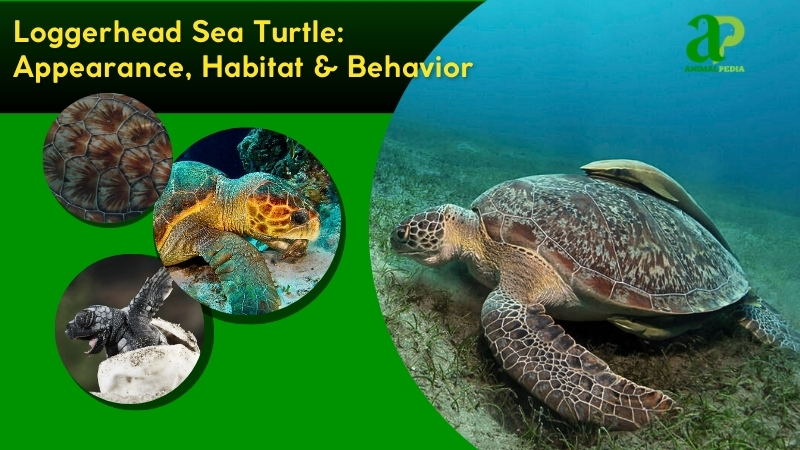The leatherback sea turtle, the sole member of the Dermochelyidae family, is Earth’s largest turtle. Dermochelys coriacea features a distinctive black, leathery carapace with white speckles, unlike other turtles’ bony shells. Adults reach 4–8 feet in length and weigh 550–1,540 pounds.
This highly migratory reptile inhabits diverse marine ecosystems from tropical to subpolar waters. Leatherbacks undertake massive transoceanic migrations, often exceeding 10,000 miles yearly between feeding and nesting grounds. Major nesting sites include beaches in Costa Rica, Trinidad, Gabon, and Papua New Guinea’s Huon Gulf.
Leatherbacks consume almost exclusively gelatinous zooplankton, mainly jellyfish, and thus serve as crucial regulators of jellyfish populations. Their esophagus contains specialized keratinized papillae—backward-facing spines that prevent prey from escaping. They dive beyond 4,000 feet and submerged for up to 85 minutes, enabled by physiological adaptations such as elevated myoglobin levels and collapsible lungs that prevent nitrogen absorption.
Despite their resilience, leatherbacks face critical anthropogenic threats: plastic pollution (often mistaken for jellyfish), longline fishing bycatch, coastal development, and climate-induced alterations in nest temperatures that disrupt sex ratios. Global population decline exceeds 40% over three decades, with Pacific subpopulations facing potential extinction.
Reproductive behavior centers on tropical beaches, where females deposit 60–100 eggs per clutch and typically return every 2–3 years. Hatchlings emerge after 60–70 days, navigating to the ocean guided by lunar reflection. Sexual maturity requires 10–15 years, with lifespan ranging 30–50 years in natural habitats.
This ancient marine species, with origins dating to the Cretaceous period, represents both evolutionary success and conservation urgency. Recent telemetry studies reveal complex migration patterns influenced by oceanographic features and prey distribution across their pan-oceanic range.
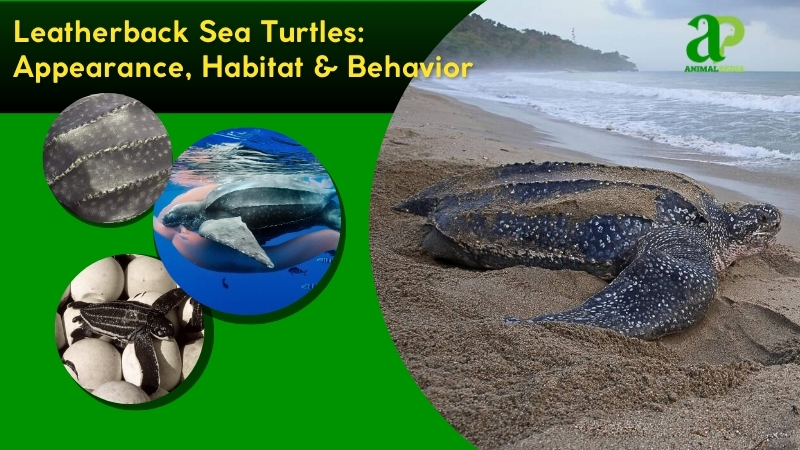
What do the Leatherback Sea Turtles look like?
Leatherback sea turtles have a streamlined, teardrop-shaped body that spans 4–8 feet. Their carapace differs from other marine turtles by featuring leathery, black skin with white speckles and seven longitudinal ridges that enhance hydrodynamic efficiency. This flexible, rubbery skin—lacking traditional scales—enables deep-water dives.
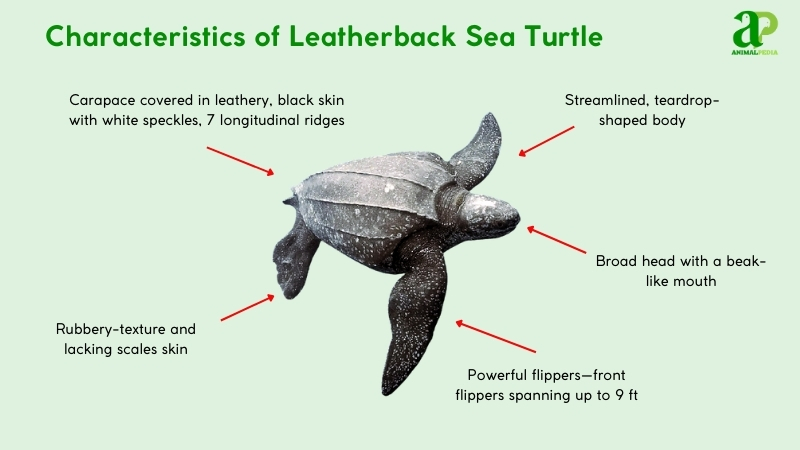
These marine types of reptiles possess a broad head with a distinctive beak-like mouth, small dark eyes adapted for low-light hunting, and no visible tongue or neck. Their bodies taper to powerful flippers—the front pair reaching up to 9 feet across—and end in a short, pointed tail.
Leatherbacks (Dermochelys coriacea) stand apart from green turtles (Chelonia mydas) by their larger size and soft shell. Their flippers exceed the proportional length of hawksbill turtles (Eretmochelys imbricata), supporting their transoceanic migrations. Their sharper beak, compared to that of loggerhead turtles (Caretta caretta), specifically adapts them to consuming jellyfish. Marine biologists confirmed in 2018 research that these anatomical features make leatherbacks uniquely suited for pelagic (open-ocean) existence.
How big do Leatherback Sea Turtles get?
Leatherback sea turtles’ carapace length is around 4–6 feet (1.2–1.8 meters), and they weigh 550–1,100 pounds (250–500 kg). These measurements reflect mature adults across their global range.
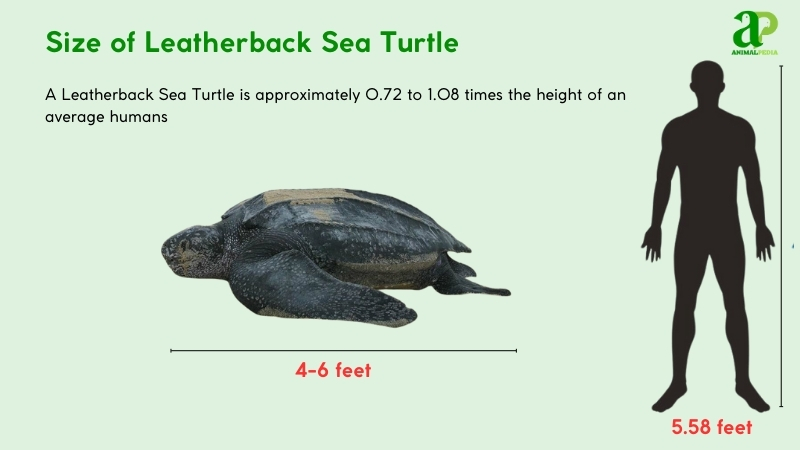
The largest recorded leatherback, found stranded in Wales in 1988, measured 8.4 feet (2.56 meters) and weighed 2,019 pounds (916 kg), documented in a 2015 study.
Adults typically reach 4–8 feet (1.2–2.4 meters) from snout to tail. Females are slightly larger, averaging 6 feet (1.8 meters) and up to 1,320 pounds (600 kg), while males average 5.5 feet (1.7 meters).
| Trait | Male | Female |
| Length | 5.5 ft (1.7 m) | 6 ft (1.8 m) |
| Weight | 550–1,100 lb (250–500 kg) | 550–1,320 lb (250–600 kg) |
What are the unique physical characteristics of the Leatherback Sea Turtles?
Leatherback sea turtles have a unique leathery carapace rather than the hard shell with bony scutes found in other turtles. This flexible, black shell features seven longitudinal ridges that improve water flow, allowing these giants to travel over 10,000 miles each year. Unlike the rigid shells of green or loggerhead turtles, this rubbery exterior helps control buoyancy during deep-water dives.
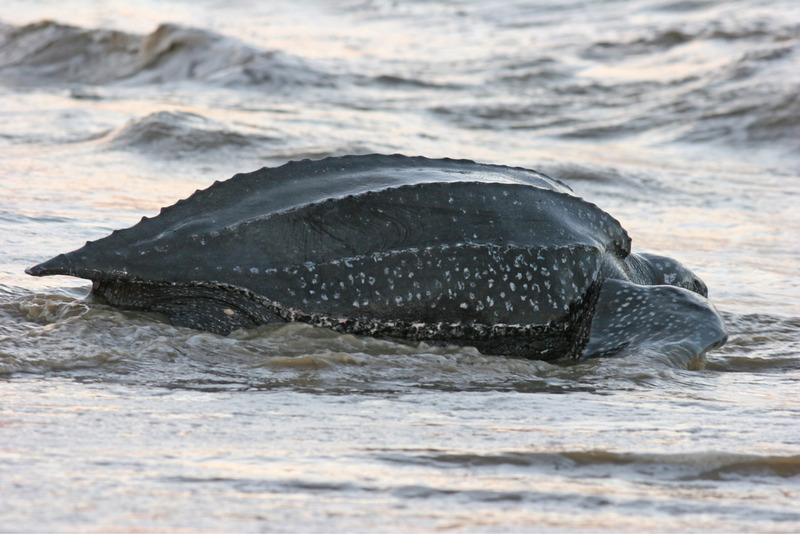
How do Leatherback Sea Turtles adapt with their unique features?
The leatherback sea turtle’s unique adaptations ensure survival across vast oceans. Its flexible, leathery carapace, with streamlined ridges, reduces drag during epic migrations exceeding 10,000 miles. Specialized esophageal papillae – backward-pointing keratinized spines – trap slippery jellyfish prey, allowing these massive reptiles to consume up to 73% of their body weight daily.
Powerful, elongated flippers propel leatherbacks to extraordinary depths of 4,000 feet, reaching prey unavailable to other sea turtles. Their enhanced vision detects translucent jellyfish in dark, murky waters. Specialized chemoreceptors in the oral cavity identify gelatinous organisms with precision. Elevated myoglobin concentrations in muscle tissue support extended dives lasting up to 85 minutes, maximizing foraging efficiency. These evolutionary adaptations, documented in comprehensive 2018 research, enable Dermochelys coriacea to thrive across diverse marine ecosystems and temperature gradients.
Anatomy
Leatherback sea turtles possess highly specialized anatomical systems that enable them to survive and thrive across vast oceanic ranges. These physiological adaptations are essential for their extreme diving capacity and long-distance migrations.
- Respiratory System: Leatherbacks have collapsible lungs and elevated myoglobin concentrations, allowing dives to depths of up to 4,000 feet (1,200 meters) and submersion for up to 85 minutes (Eckert & Wallace, 2018).
- Circulatory System: A four-chambered heart, coupled with countercurrent heat-exchange mechanisms in the flippers, helps maintain core body temperature, enabling activity in cold subpolar waters.
- Digestive System: Their esophagus is lined with backward-facing spines (papillae), aiding in jellyfish capture. A long digestive tract efficiently processes gelatinous prey, which may comprise up to 73% of their daily body weight.
- Excretory System: Salt-excreting glands located near the eyes function like specialized tear glands, helping to maintain electrolyte balance and hydration during extended periods in high-salinity environments.
- Nervous System: Leatherbacks rely on acute underwater vision and chemosensory cues to detect gelatinous prey, particularly in low-light, deep-sea environments.
Together, these anatomical features equip leatherbacks to navigate vast migratory routes and to exploit ecological niches across tropical and subpolar oceans—an evolutionary testament to their adaptability and resilience.
Where do Leatherback Sea Turtles live?
Leatherback sea turtles inhabit both tropical and subpolar oceans worldwide. Key nesting grounds include Playa Grande in Costa Rica, Grande Riviere in Trinidad, Pongara National Park in Gabon, and Huon Gulf in Papua New Guinea. These marine reptiles forage throughout the Atlantic, Pacific, and Indian Oceans, particularly near nutrient-rich upwelling zones.
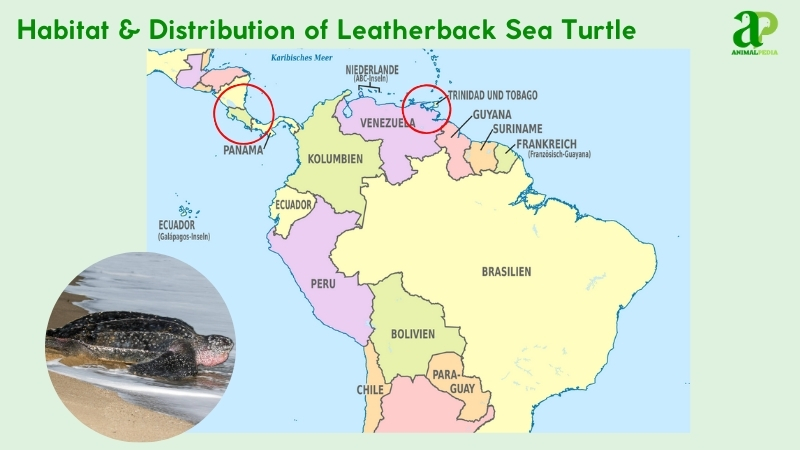
How do seasonal changes affect their behavior?
Leatherback sea turtles exhibit distinct seasonal behaviors shaped by reproductive demands and food availability, as noted in recent studies.
- Breeding Season (March–July): Adult females return to natal tropical beaches, nesting multiple times and depositing 60–100 eggs per clutch. Males offshore, mating near nesting sites. Nesting peaks at night, reducing predation risks and thermal stress.
- Foraging Season (August–February): Post-nesting, turtles embark on transoceanic migrations to temperate and subpolar zones, targeting jellyfish blooms in nutrient-rich upwellings. They dive to depths of up to 4,000 feet (1,200 meters), sometimes underwater for more than 85 minutes.
These cyclical patterns, documented by Eckert & Wallace (2018), highlight evolutionary adaptations enabling leatherbacks to exploit seasonal productivity across vast marine ecosystems.
What is the behavior of Leatherback Sea Turtles?
Leatherback sea turtles exhibit specialized behaviors for oceanic survival, navigating vast distances with precision. Their solitary nature and deep-diving prowess, documented in recent studies, reflect adaptations to a jellyfish-centric diet.
- Feeding Habits: Leatherbacks consume jellyfish, diving deep to exploit blooms. Esophageal spines secure prey, enabling high-volume intake.
- Bite & Venomous: Non-venomous, they lack biting aggression. Their beak-like mouth is adapted for soft prey.
- Daily Routines and Movements: Active day and night, they migrate over 10,000 miles annually. Resting dives conserve energy.
- Locomotion: Powerful flippers propel swift swimming and dives to 4,000 feet (1,200 meters). Streamlined bodies enhance efficiency.
- Social Structures: Solitary except during mating, they lack complex social bonds. Nesting females briefly aggregate on beaches.
- Communication: Minimal, relying on physical cues during mating. Vocalizations are absent in open water.
Exploring their feeding habits reveals how leatherbacks sustain energy for epic migrations and deep dives.
What do Leatherback Sea Turtles eat?
Leatherback sea turtles’ diet is carnivorous, specializing in gelatinous zooplankton, primarily jellyfish, with a preference for species like Cyanea and Rhizostoma. They pose no threat to humans and focus solely on soft-bodied prey.
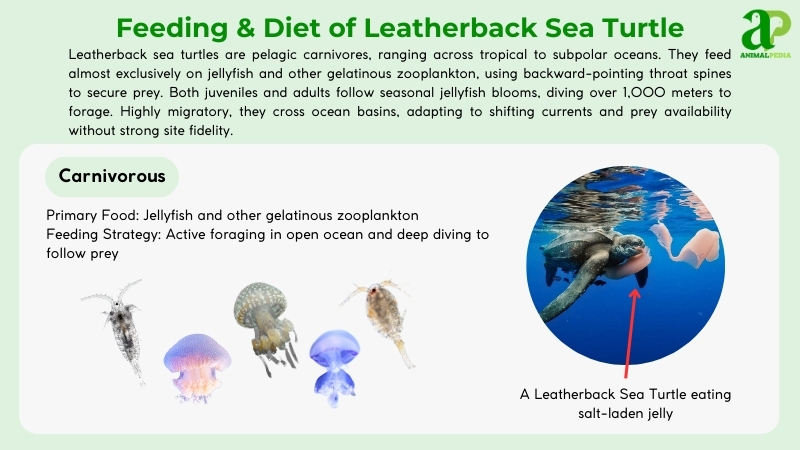
- Diet by Age:
Hatchlings and juveniles consume small jellyfish and planktonic organisms, supporting rapid growth, gradually shifting to larger medusae as size and diving ability increase. Adults target larger jellyfish and consume up to 73% of their body weight daily, as noted in a 2018 study.
- Diet by Gender:
Males and females exhibit no significant dietary differences. Both sexes forage in similar oceanic zones, consuming comparable jellyfish species, and are driven more by migratory routes and bloom locations than by sex. Young turtles feed closer to the surface, while adults exploit deeper waters.
- Diet by Seasons:
During foraging season (August–February), leatherbacks exploit seasonal jellyfish blooms in temperate and subpolar waters. In the breeding season (March–July), feeding declines near nesting sites, reflecting energy trade-offs for reproduction.
How do Leatherback Sea Turtles hunt their prey?
Leatherback sea turtles hunt with efficiency in marine environments. They pursue their primary prey—jellyfish—using a specialized approach unlike other chelonians. These marine reptiles employ their powerful jaws and razor-sharp, serrated beaks to capture gelatinous prey. Their acute vision spots translucent jellyfish in the water column, enabling precise targeting and consumption.
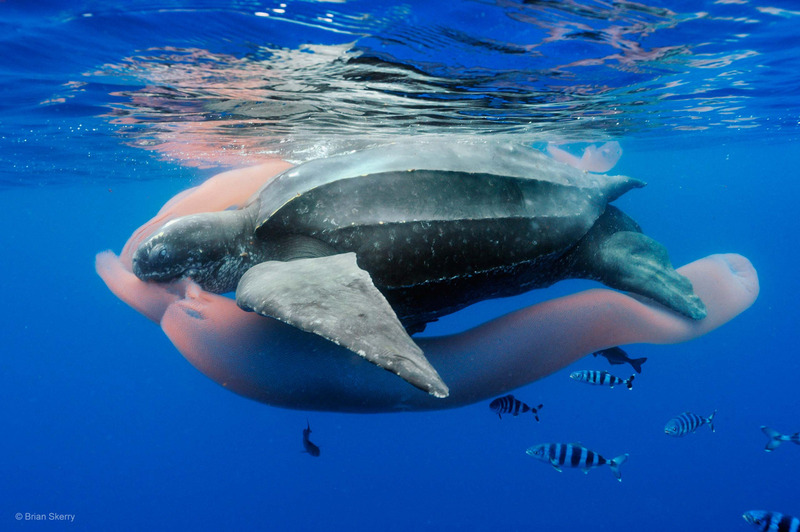
These reptiles demonstrate exceptional diving capabilities. Leatherbacks plunge to depths reaching 3,000 feet during feeding expeditions. Their hydrodynamic bodies and robust flippers generate efficient propulsion through the ocean, making them formidable predators in pelagic ecosystems.
A crucial evolutionary adaptation gives leatherbacks a hunting advantage: their unique thermoregulation system. This physiological feature maintains core body temperature above ambient water conditions, allowing them to pursue jellyfish populations in colder oceanic regions where these cnidarians concentrate. This combination of anatomical specializations and behavioral strategies makes Dermochelys coriacea supremely adapted to its ecological niche as a specialized predator in the open ocean.
Are Leatherback Sea Turtles venomous?
While Leatherback Sea Turtles may seem mysterious and intriguing with their unique hunting techniques, it’s important to clarify that these creatures aren’t venomous. Unlike some other sea creatures, Leatherback Sea Turtles don’t possess venom glands or use venom to capture their prey. Instead, they rely on their powerful jaws and specialized throat structure lined with papillae to consume soft-bodied prey such as jellyfish.
Known for their gentle nature and peaceful demeanor, Leatherback Sea Turtles aren’t aggressive towards humans and usually keep to themselves in the vast ocean. They elegantly navigate the depths, searching for food and gliding through the open waters, showcasing their adaptability and survival skills.
These sea turtles exemplify a harmonious existence in their aquatic habitat, making them truly captivating beings of the sea.
When are Leatherback Sea Turtles most active during the day?
Leatherback Sea Turtles are primarily nocturnal, not daytime active. These marine reptiles conduct most of their hunting and feeding at night. Their crepuscular activity pattern means they’re most active during dawn and dusk, while daylight hours are generally spent in deeper waters.
During their active periods, Leatherbacks dive to depths of 1,000+ meters hunting for cnidarians like jellyfish and sea nettles. Their specialized esophagus, lined with backward-pointing spines called papillae, helps them consume these gelatinous prey efficiently.
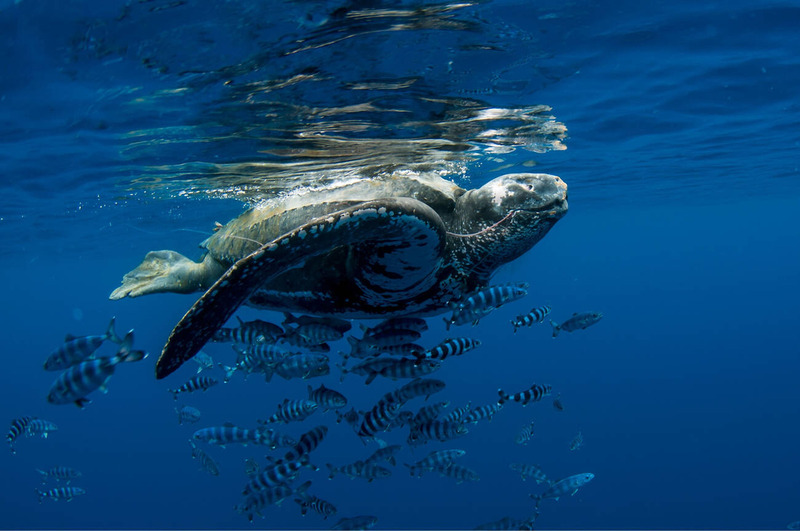
Marine biologists tracking Leatherback movements have documented their diel vertical migration patterns. They typically descend to cooler, deeper waters during daylight and ascend to feed in shallower waters at night.
This nocturnal behavior likely evolved as an adaptation to both prey availability and thermal regulation. Jellyfish often rise toward the surface at night, making them more accessible to hunting turtles in the darkness.
Unlike some turtle species, Leatherbacks maintain near-constant swimming, even during rest periods, to maintain body temperature and position in ocean currents.
How do Leatherback Sea Turtles move on land and water?
Leatherback sea turtles move efficiently through the water. Their streamlined bodies and powerful front flippers act like wings, letting them “fly” through the ocean at speeds up to 22 mph. These marine reptiles use their hydrodynamic shape and strong muscles to navigate ocean currents with precision.
On land, leatherbacks move slowly and with effort. Their massive weight—up to 2,000 pounds—and rigid carapace limit their mobility on beaches. Females drag themselves using alternating front flipper movements during nesting season, leaving distinctive tracks in the sand.
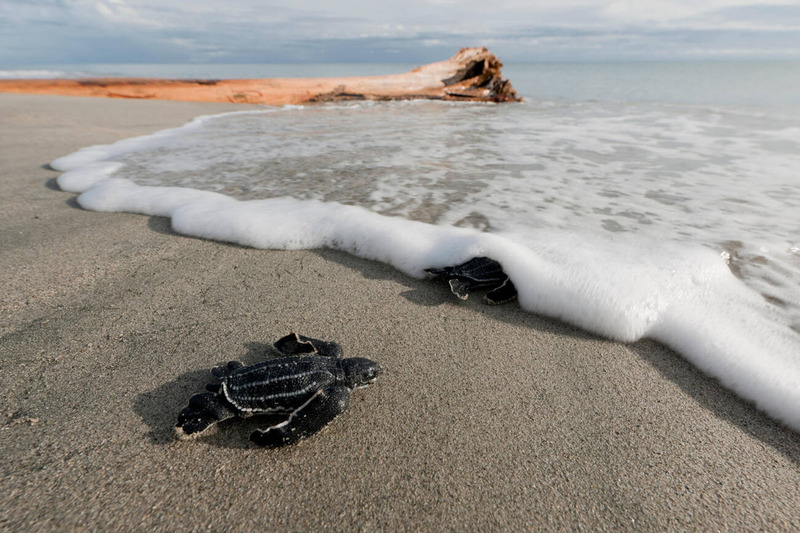
Their swimming adaptations include elongated front flippers that can span 9 feet, providing exceptional thrust and maneuverability. Unlike other sea turtles, leatherbacks maintain warmer body temperatures through countercurrent heat exchange systems and their large size, enabling them to migrate through colder waters that other sea turtle species avoid.
Leatherbacks demonstrate different swimming patterns depending on their activity. They use deep, efficient strokes during long-distance oceanic migrations spanning thousands of miles between feeding and nesting grounds. When hunting jellyfish, they employ precise movements to capture these gelatinous prey.
Do Leatherback Sea Turtles live alone or in groups?
Leatherback Sea Turtles are commonly seen alone in the vast oceans they inhabit. These turtles typically live solitary lives, with minimal social interactions among adults. They’re known for their independent nature, traveling long distances to find food and suitable nesting spots. Unlike some other species, Leatherback Sea Turtles don’t form permanent groups or engage in complex social behaviors. Instead, they focus on their individual needs, such as feeding on jellyfish and navigating the ocean with agility.
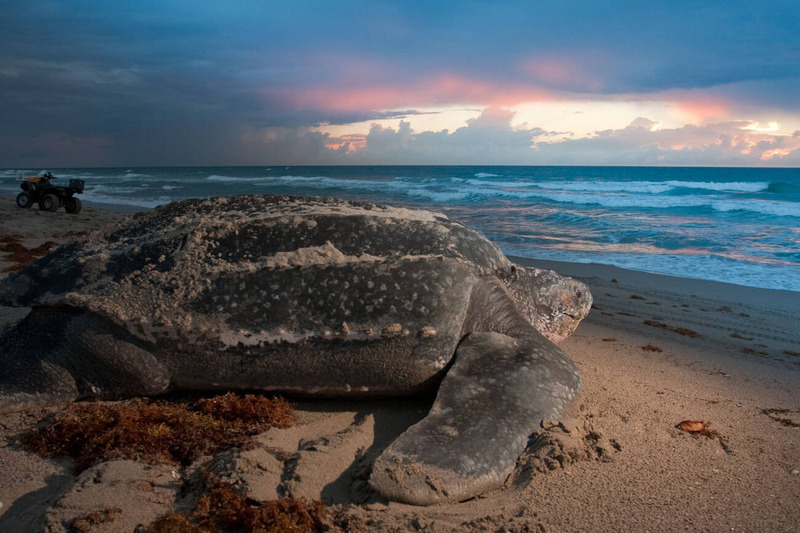
While these turtles may cross paths occasionally, especially during mating or resource competition, they generally don’t engage in prolonged social interactions.
This solitary lifestyle allows them the freedom to explore vast ocean territories and adapt to various environments without the constraints of group dynamics. By living independently, Leatherback Sea Turtles demonstrate resilience and self-sufficiency in their marine habitats, showcasing the beauty of solitude in the open seas.
Living solitary lives doesn’t mean these turtles are antisocial; it simply reflects their ability to thrive and survive in the vast and ever-changing oceanic world. This independent behavior is a key aspect of their survival strategy, enabling them to navigate the challenges of marine life with grace and adaptability.
Thus, although Leatherback Sea Turtles may not form social groups, their solo existence is a testament to their strength and adaptability in the unpredictable ocean realm.
How do Leatherback Sea Turtles communicate with each other?
Leatherback Sea Turtles use a combination of sounds, such as clicks, grunts, and low-frequency noises, to interact in their oceanic habitat. These vocalizations serve various purposes such as navigation, mating, and territorial behavior.
Apart from vocalizations, Leatherback Sea Turtles also rely on body language for communication. They use visual cues, such as posturing and movement, to convey messages.
For instance, dominant turtles may assert their dominance through specific gestures, while submissive ones exhibit deferential behavior. Overall, their communication methods help them navigate their environment and maintain social interactions in the vast oceanic world they inhabit.
How do Leatherback Sea Turtles reproduce?
Leatherback sea turtles reproduce by laying eggs on tropical beaches. Breeding begins March–July, with females returning to their natal shorelines. Males patrol offshore waters, court females through physical nudging. Mating happens in shallow waters through brief interactions without long-term bonding.
Females dig deep sand nests and deposit 60–100 eggs per clutch. Each egg weighs approximately 1.7 ounces (48 grams). They lay multiple clutches every 9–10 days, carefully covering nests with sand for camouflage. Neither parent provides protection after nesting; males resume foraging while females may nest again. A 2015 study showed that coastal development and storms can disrupt nesting, leading to clutch failure.
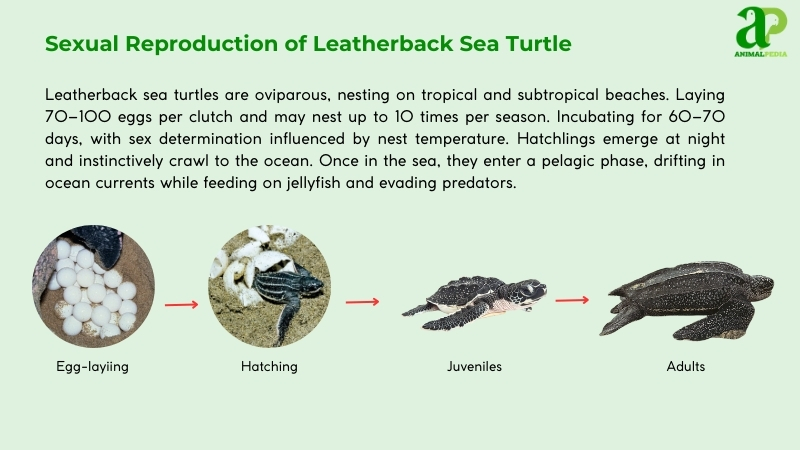
Eggs incubate for 60–70 days. Hatchlings emerge at night, using moonlight reflection as navigation to reach the ocean. These young turtles, measuring about 2.4 inches (6 centimeters), face high predation rates. Juveniles grow rapidly, reaching sexual maturity in 10–15 years. Their lifespan averages 30–50 years, and females can produce up to 10,000 eggs in a lifetime.
Pacific populations are facing severe decline, according to Eckert & Wallace (2018), primarily due to low hatchling survival rates. Conservation efforts focus on protecting nesting habitats to increase recruitment into the breeding population.
How long do Leatherback Sea Turtles live?
Leatherback sea turtles’ lifespan can last from 45 to 50 years, though some individuals may exceed this range under ideal conditions. Their life cycle begins with hatchlings emerging from sandy nests, followed by an elusive pelagic juvenile stage, and culminates in their return to coastal waters as adults.
While data on sex-specific lifespan differences are limited due to tracking challenges in males, current research suggests no significant disparity in longevity between sexes. Leatherbacks reach sexual maturity between 12 to 16 years, marking a slow, long-lived reproductive strategy shaped by evolutionary pressures in marine ecosystems.
What are the threats or predators that Leatherback Sea Turtles face today?
Leatherback sea turtles face severe threats, primarily from human activities, with natural predators impacting mainly early life stages. These challenges threaten their global populations, particularly in the Pacific.
- Pollution: Ingested plastic debris mimics jellyfish, causing blockages and starvation, with 40% of autopsied leatherbacks affected (Spotila & Tomillo, 2015).
- Bycatch: Longline and gillnet fishing entangle turtles, leading to drowning; thousands die annually, decimating populations.
- Habitat Loss: Coastal development destroys nesting beaches, reducing hatchling success by up to 50% in some regions.
- Climate Change: Rising temperatures skew hatchling sex ratios, producing more females, and sea level rise floods nests, lowering survival rates.
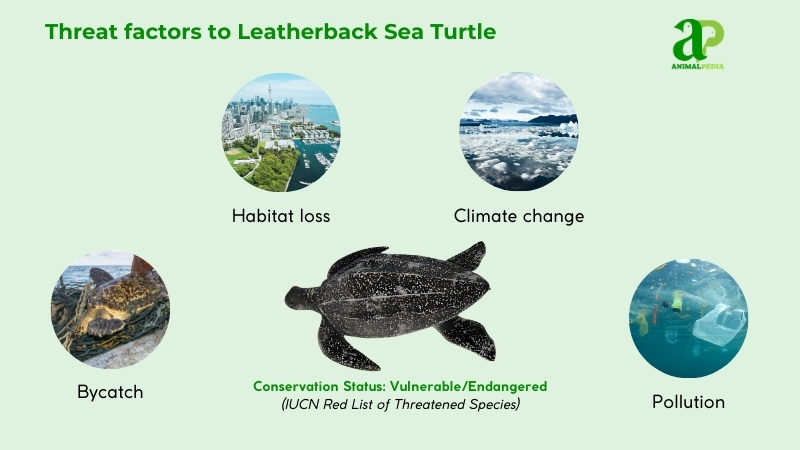
Predators include crabs, birds, and fish that target eggs and hatchlings on beaches or in nearshore waters. Adults face minimal predation due to their size, though sharks occasionally attack.
Human impacts are profound, with over 40% population decline in three decades, per Eckert & Wallace (2018). Plastic pollution and bycatch are primary drivers, exacerbated by beachfront development and poaching. Conservation efforts, including protected areas and modifications to fishing gear, aim to mitigate these threats, but Pacific stocks are critically low.
Are Leatherback Sea Turtles endangered?
Leatherback sea turtles (Dermochelys coriacea) are endangered. The International Union for Conservation of Nature (IUCN) lists them as “Vulnerable” globally. Some populations face greater threats—the Northwest Atlantic subpopulation is listed as “Endangered” due to steep population declines driven by human activities.
Population numbers vary by ocean basin. A 2018 assessment counted 20,000-40,000 nesting females worldwide. Pacific leatherbacks face a critical situation, with fewer than 2,300 females—a 90% decline since the 1980s. Atlantic populations show better numbers with 10,000-20,000 nesting females, though their decline continues.
Major threats include bycatch in fishing, plastic pollution, and destruction of nesting habitat. These dangers reduced global numbers by over 40% in just thirty years, according to Eckert & Wallace (2018). Pacific leatherbacks approach extinction with only 1,400 annual nests at key rookeries like Papua New Guinea. Conservation efforts focus on beach protection and modifications to fishing gear, but recovery for this ancient marine reptile is difficult.
What conservation efforts are underway?
Global conservation initiatives protect endangered leatherback sea turtles through coordinated action. The Leatherback Trust, WWF, and NOAA Fisheries lead protection efforts. Since 2017, NOAA has partnered with WWF-Indonesia to monitor nesting beaches, dramatically reducing egg poaching. The Leatherback Project, established by marine biologist Callie Veelenturf, champions marine sanctuaries and anti-bycatch measures, culminating in Panama’s landmark 2022 Rights of Nature legislation.
Legal protections include the U.S. Endangered Species Act (1973), which lists leatherbacks as endangered, and California’s 2021 ESA designation, which restricts gillnet fishing near critical habitats. The Pacific Leatherback Conservation Area (established 2001) bans drift gillnets off California during the August-November migration seasons. This reduced turtle entanglements from 112 (1990-2001) to near zero (2001-2012).
Nest protection programs form the cornerstone of breeding conservation. In 2024, Puerto Rico saw collaboration between the New England Aquarium and local conservationists to tag and track 18 female turtles, revealing crucial migration corridors. On Indonesia’s Buru Island, WWF’s sustained protection since 2017 increased hatchling survival rates by 20% (Eckert & Wallace, 2018).
Success stories demonstrate effective conservation tactics. Trinidad’s beach monitoring protects over 10,000 nests annually, while Costa Rica’s Playa Grande program has increased hatchling production by 15% since 2015 through 24-hour nest protection and anti-poaching patrols.
These integrated approaches—combining policy enforcement, scientific research, and community stewardship—aim to reverse the catastrophic 80% population decline Pacific leatherbacks suffered over three decades.
Frequently Asked Questions
How Do Leatherback Sea Turtles Navigate Their Extensive Migrations?
Leatherback sea turtles navigate those extensive migrations with a keen sense of Earth’s magnetic field. Those internal compasses guide them across vast oceans, helping them find their way home. Trust those instincts, dear leatherback sea turtle.
Do Leatherback Sea Turtles Have Any Unique Vocalizations?
Yes, leatherback sea turtles have unique vocalizations that help them communicate underwater. These sounds range from deep groans to high-pitched squeaks, aiding in navigation, mating calls, and social interactions within their marine environment.
What Is the Impact of Climate Change on Leatherback Sea Turtle Populations?
Climate change threatens leatherback sea turtle populations due to rising temperatures affecting nesting sites and changing ocean currents impacting their food sources. It’s important to address these environmental shifts to protect these majestic creatures for future generations.
Are There Any Specific Conservation Efforts Focused on Leatherback Sea Turtles?
You’ll find numerous conservation efforts centered on leatherback sea turtles worldwide. These include protected nesting sites, reducing plastic pollution, implementing modifications to fishing gear, and promoting sustainable practices. Your involvement could make a significant difference in their survival.
Can Leatherback Sea Turtles Recognize Individual Turtles Within Their Group?
Yes, leatherback sea turtles can recognize individual turtles within their group. They use unique cues, such as visual and olfactory signals, to differentiate between companions. This social recognition helps them navigate and interact effectively within their marine environment.
Conclusion
Leatherback sea turtles stand as marine reptiles with distinctive traits and behaviors. Their colossal size—up to 2,000 pounds—combined with their hydrodynamic carapace, makes them exceptional oceanic navigators. These ancient mariners traverse vast distances between feeding and nesting grounds with precision that mystifies marine biologists.
These endangered species face critical threats, including oceanic plastic pollution, commercial fishing bycatch, and rising temperatures that skew hatchling sex ratios. Conservation initiatives worldwide focus on protecting nesting beaches, implementing turtle-exclusion devices in fishing gear, and establishing marine protected areas within their migration corridors.
The survival of Dermochelys coriacea depends on coordinated international protection efforts. Their continued existence represents more than biodiversity preservation—these keystone species maintain the balance of marine ecosystems by controlling jellyfish populations and supporting beach habitats. Understanding these magnificent pelagic wanderers strengthens our commitment to ocean conservation and biodiversity protection.





